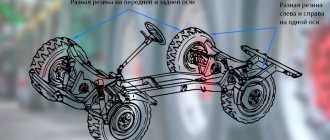There are no rules in the Code of Administrative Offenses of the Russian Federation establishing a fine for using tires out of season
The issue of using the appropriate type of tires - winter or summer - especially begins to worry motorists during the calendar off-season: with the onset of cold weather in the fall and after warming in the spring. At this time, rumors traditionally spread online about possible administrative liability in case of violation of legal requirements regarding the operation of tires and wheels.
How true is this information, what regulations say, when to change tires to winter tires in 2021 according to the law, we will talk about all this later in the article.
When should you change your car's shoes in winter 2021?
According to official law, from December 1, 2021. If somewhere you see data that you need to change to winter tires from November 1 or even October or in other dates in the legislative context, then this is not true.
The legislation clearly and precisely defines the terms within which it is necessary to use only winter tires:
- December (not November),
- January,
- February 2021.
In general, this is all you need to know about the law on winter tires and the timing of their replacement in Russia. If you need “proofs”, then they are lower! It is also important to know the specific requirements for winter tires on your car.
What does the law say?
Here's what:
5.5... It is prohibited to operate vehicles that are not equipped with winter tires that meet the requirements of paragraph 5.6.3 of this appendix during the winter period (December, January, February). Winter tires are installed on all wheels of the vehicle. The terms of the operation ban may be changed upward by regional government bodies of the member states of the Customs Union.
This is an excerpt from the Technical Regulations. The same is written in the traffic rules. As you can see, there is no November, and regarding the time when you need to switch to winter tires, there are 2 important subtleties:
- paragraph 5.5 of the regulations refers to another - 5.6.3 in terms of meeting the requirements for winter tires, even if installed within the period prescribed by law,
- Regional administrations can apply their own rules when changing a car to winter tires.
Regarding the last point, we have good news for you - as of 2021, not a single region of Russia has changed the general procedure for tire replacement periods, and throughout the country you need to wear winter tires starting from the first day of December.
But we need to pay a little more attention to the first point - this is where we are given clear criteria for what winter tires are according to the law in principle. And let's find out!
Are there only summer tires until December?
Of course no. For summer tires, the requirements do not apply to the entire remaining 9 months. It is simply prohibited to drive on winter tires during the summer months - June, July and August, this is prescribed by the same paragraph 5.5 of the Technical Regulations. So, in October or November, for example, you can drive either summer or winter tires.
When to change tires
1. After winter, studded winter tires need to be changed as soon as the snow melts and the average daily temperature rises above zero.
You shouldn’t hesitate to “change your shoes,” since at high temperatures, winter tires will quickly wear out, and the studs will simply fly out due to the heating of the rubber while driving on clean asphalt.
In addition, “spikes” on the asphalt noticeably increase the braking distance, which affects traffic safety.
2. “Velcro” should be changed when the temperature reaches a stable temperature above +5 degrees at night. Delay in replacement risks rapid wear of the tread.
3. When preparing a car for the winter season, it is recommended to wear Velcro at the first frost, and studded ones - when the average daily temperature drops below zero degrees.
- It is best to have a separate set of tires already mounted on the rims for each season.
- This will simplify the process of “changing shoes” of the car and protect the tires from unnecessary manipulations during tire fitting.
Watch a useful video on when and how to change winter tires to summer ones:
Rubber storage
- Tires and rims should be stored in a dry, ventilated place, having first cleaned and washed them. The average shelf life of tires is about 5 years. After this period, the rubber begins to lose elasticity, become rough and crack.
- Typically, Velcro lasts two to three seasons, but tires with studs can last four seasons, because non-studded winter tires are installed on the car earlier and removed later.
- Summer tires last approximately three seasons or 40,000–45,000 km. mileage
- “All-season vehicles” last for about three years, however, under the condition of gentle operation, that is, without sudden braking and acceleration with slipping.
Any tire has its own strength limit.
There is a special plate on the tires that indicates the so-called “speed and load index”.
This indicator means that the tire can withstand the speed indicated on the plate without negative consequences for 30 minutes. If these standards are not observed, the rubber may collapse at full speed, with all the ensuing negative consequences.
Interesting video, 3 rules for proper tire storage:
Car tire repair
In many cases, damaged tires can be repaired.
Tires with damage at the junction of the sidewall and tread, as well as with damage to the bead, cannot be repaired.
The fact is that these places are constantly deformed during movement, so the patches do not stick to them. Most other damage is repaired by hot vulcanization, but you need to understand that this does not restore the cord threads.
Where to change tires?
You need to change the tires on your car in those services for which such work is specialized.
Preference should be given to serious companies, where specialists will clearly explain everything they will do with tires and wheels. And you can pass the time while the car is being “changed” in a comfortable waiting room.
- It is advisable to buy tires not at the market, where they are stored in stacks and where they will get you the lowest ones, which may have a deformed cord.
- Buy rubber where they are properly stored on special racks.
You can check the correct installation of tires by eye.
Video about dismantling and installing a car tire:
Balancing
Before balancing the wheels, you need to inspect the treads and remove all the stones and lumps of dirt that have got there, and then wash them.
Weights must be installed both on the outside and on the inside. In this case, there should not be more than one weight on one side, otherwise the wheel can be considered incorrectly balanced.
The wheel and tire must not be damaged. When the car is moving at a speed of 90-100 km/h, vibration of the steering wheel should not be felt.
Watch a video about proper wheel balancing:
- It is recommended to balance wheels after driving every 5,000 km, as well as after repairing a tire or wheel.
- It is advisable to check the wheel alignment once a year or do this in accordance with the manufacturer's recommendations.
- Don't forget to regularly check your tire pressure.
Important note!
- This article provides basic information, but each case is different.
- In 92% of all situations there are important nuances that can affect the outcome of the entire case.
- An experienced lawyer will study all the materials of the case and indicate in which direction to move.
Therefore, our website employs on-duty legal consultants who delve into each case and are aimed at solving it.
Ask a Question
or consult toll-free (Moscow), (St. Petersburg), 8 (all of Russia).
What tires are considered winter tires by law?
Everything is quite simple here too! The winter tires that you change from summer tires to December must have 2 essential attributes; without them, they are not considered winter tires, and you, therefore, violate the rules of the regulations:
- marking in the form of a mountain with 3 peaks and a snowflake inside,
- written designation with a combination of the letters M and S.
This is what the marking looks like:
This is what a real winter tire looks like with it:
And the law does not prescribe any differences for winter tires according to their type - be it studded tires, Velcro or all-season.
Other requirements
Another important requirement for winter tires is a limit on their wear. Specific figures are given in the traffic rules - 4 millimeters, this is the permissible remaining tread depth of winter tires. But there is an exception - if your tire is equipped with wear indicators, then you can use such tires until the last indicator.
Also among the requirements for any type of tires:
- absence of side cuts and cracks in which the cord is visible (if the cord is not visible, then you can ride),
- no tire delamination,
- the speed and weight index of the vehicle must correspond to
- all bolts or nuts on the wheels must be present,
- If the tires are studded, then the car must have a Studs sign.
What's the fine?
If you did not have time to change your shoes to winter tires in the 2021 season and are driving on summer tires, then... there will still be no fine!
The fact is that the Code of Administrative Offenses in force today provides for traffic police fines for violations of the Traffic Rules. But the obligation to change summer tires to winter ones is not specified in the traffic rules, but, as we quoted above, in the Technical Regulations. There are no penalties for violations of this regulatory act in 2021.
Information is being circulated online that as of December 1, 2021, a fine has been introduced for summer tires in winter. This is nothing more than a myth and you will not find official confirmation of it anywhere.
Everything is quite clear and simple here:
- There is no fine directly for the fact that you did not change your car to winter tires,
- but there are sanctions for non-compliance with tread depth and other requirements for winter tires.
What if a traffic police officer wants to fine you?
Then, with a high degree of probability, he is going to issue a resolution under Part 1 of Article 12.5 of the Code of Administrative Offenses. It provides for punishment in the form of a fine of 500 rubles for non-compliance with the Basic Provisions of the Traffic Regulations, namely, they contain the above requirements for tread depth after tire wear, the presence of a cord, the absence of nuts/bolts and others.
The resolution will say so - violation of clause 5.1 or other Basic Provisions for Vehicle Admission. But the majority of drivers, due to inattention, will not look at the regulation and will assume that they were given a fine for not changing their summer tires to winter ones. And even if they later see that the violation was replaced by a traffic police inspector, it will be difficult to prove the opposite.
Car tire service life, wear and tear prevention video AvtoNovator
Despite the bold statements of tire manufacturers that the service life of summer car tires reaches ten years, you still need to change the shoes of your “iron horse” much more often, about once every 5-6 years.
Tire life - signs of its end
Good, high-quality, and most importantly, intact tires are the key to safe driving. Therefore, you should not forget about the specified deadlines, but this is not a panacea.
It is important to monitor the condition of your tires, both summer and winter; sometimes even 5 years of service will be too bold an expectation. There are special indicators that can be used to determine the degree of damage. They act as jumpers between the tread, and as soon as it wears down to their level, the service life of the tires has expired
In addition, numbers of varying depths are often stamped on the surface of the rubber, and by how many numbers are visible, one can judge the degree of wear. You can also use a special ruler with a depth gauge and measure the tread height yourself; this parameter should be 1.6 mm or more for summer tires and at least 4 mm for the snow season. In case of uneven wear, measurements should be taken on the most damaged part.
Failure can also be caused by simple mechanical damage, such as cuts, deformation due to emergency braking, or the appearance of bumps after an impact. All these factors significantly reduce the shelf life of tires.
Assessing the service life of car tires – should we trust the manufacturer?
As you know, tires are made from different types of rubber depending on the season of use. Thus, summer tires are harder than winter or all-season tires, and therefore the shelf life of summer car tires is longer. Basically, manufacturers provide a guarantee for summer tires of 10 years, and for winter tires - no more than 7. However, you should not be guided by these terms, since the quality of our roads and other associated operating conditions are far from ideal.
In addition, the service life of car tires is also affected by their quality. Therefore, you should not be under the illusion that if you buy cheap Chinese tires, you will be able to use them in the same way as expensive branded tires. Therefore, do not save, the difference in price will not be justified. After all, branded tires can be used for more than five seasons, and cheap tires can last no more than two. All-season tires still do not live up to expectations, at least for residents of regions where winter temperatures are well below zero.
The service life of car tires - can it be increased?
There can be quite a few reasons for tire wear, but they are very easy to identify; the main thing is to carefully examine the surface of the tire and the tread pattern. If the outer edges show more wear than the central part, this indicates insufficient pressure, and vice versa. And unevenly worn tread edges on only one side indicate a wheel alignment violation. In addition to wear, driving style also affects how long summer tires last. For those who enjoy extreme driving with sharp braking, the tire surface will be unevenly deformed.
We see that not only the mileage the tires are designed for has an impact, but also a lot of other factors, such as driving style, quality of the road surface, participation in accidents, etc. Do not forget about timely technical inspection, and you should also check the tire pressure at least twice a month. What about balancing, it should be done every 15,000 km. After impacts, carefully examine the surface of the rubber for the presence of foreign objects or bumps.
If you adhere to all the above rules, then the mileage standards for car tires in accordance with GOST are:
- for passenger cars with a carrying capacity of no more than two tons - 45 thousand km;
- for trucks (load capacity 2-4 tons) – 60 thousand km;
- for trucks with a carrying capacity of more than 4 tons - 65-70 thousand km.










